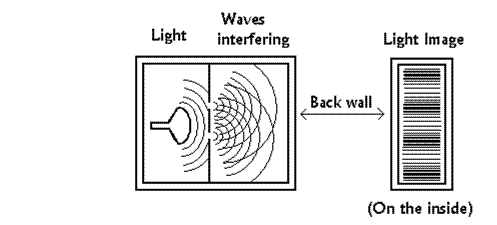Chapter 0-Page 0
In the 1770's, the device pictured below provided a means of producing secondary waves from light, a wave wide enough to see in our visual range.

At the left end of the box, a light shone in a single color (one frequency), let's say green. The screen in the middle had two slits for the light to get through. The other end of the box held another screen. If light travels in pieces as Newton thought, we should see two lines of green light, one behind each slit. That's not what happened. Instead, the light spread into an interference pattern of light and dark lines, secondary waves, as shown in the picture.
Light appears to travel in waves too.
HOW FAST DOES LIGHT GO
For a long time, people thought light traveled from one place to another in an instant. Early cave philosophers probably thought that was the case too. If they uncovered a light, it shined on the walls right away. What if light traveled slower than it really does? If they raised a hand quickly, the shadow might move later. Actually, that'd be kind of fun.
Outdoors, the primitives probably noticed they saw lightning before they heard the thunder (if they were lucky). Today, we know this effect means light travels faster than sound, but the early people probably thought the whole experience was more personal than that.
Chapter 0-Page 0